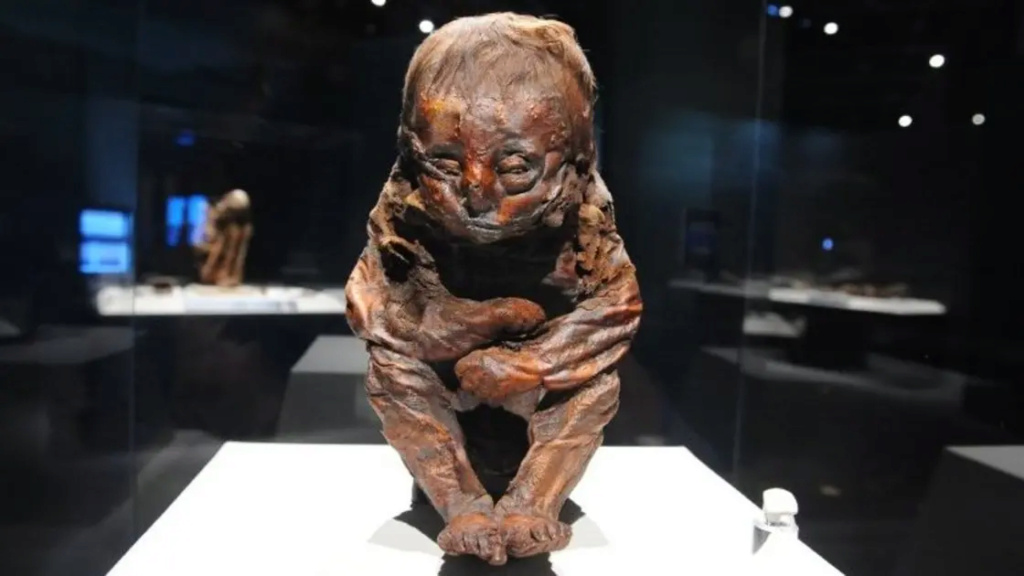Libyan mummy

For us, and perhaps for the whole world, mummification remained a purely Egyptian affair, and Libya remained an area of cultural vacuum for us, the Libyans in particular, despite the enormous and diverse cultural reserve that the Libyan sands hid from us for thousands of years.
In the last decades of Libya's long life, the amazing archive that Libya had hidden in its sand memory began to reveal to the world, not for us but for many researchers and scholars.
After the prehistoric paintings dating back ten thousand years, which were drawn on the walls of the caves of southern Libya by painters who lived here and transferred their lives and knowledge through those paintings, the biggest surprise “The Libyan Mummy” appears to us in all its details...
“Wan Mohjaj” is the name given by scientists to this mummy. It does not belong to a king, a prince, or a military commander, but rather to a young child no more than three years old, as research and analysis indicate. He was embalmed in an elaborate manner, preserving his body intact for thousands of years.
The mummy was found in Wadi Wan Mohejaj, which is the name that scientists gave to this mummy in reference to this place in the Akakus Mountains in southern Libya before.
Forty years ago, the great Italian scientist Fabrizio Mori, the mummy was buried in a rocky cavity in a cave. It was hidden in a deer skin bag and covered with plant leaves. From the moment of discovery, the journey of searching for mummification in Libya began.
We find George Muller also saying:
“There was no mummification before the arrival of the tahnu and tamhu “al-Shaqar” to Egypt, so mummification is a Libyan invention.”

George Müller adds in another article entitled: “The Egyptians and Their Libyan Neighbors”: “The Tahnu are the first ancestors of the first dynasty, and they are from the first days in the history of Egypt.”
After this discovery, another mummy was discovered in Al-Jaghbub, near the Egyptian border, and the age of the Al-Jaghbub mummy was determined to be one thousand eight hundred years, and another mummy was in the city of Ghat in the southwestern Libyan area, not far from Wan Mohjaj.
The mummified child, “Wan Mohjag,” was transported to Rome at the end of the last century
The Italian scientist "Sevino" continued his field studies of the Acacus region and everything related to the natural conditions of life there at the stage of mummification, "the end of the rainy period and the beginnings of desertification." All excavations and studies indicate that the Libyan Desert was a rainy area covered by forests and with rivers running through its dry valleys, which made human settlement possible there and which made an important civilization form and grow. The paintings of prehistoric painters point to all of this, and these paintings represent a record of life and its circumstances in that. Old time..
In Rome, the age of the mummy was determined to be five thousand five hundred years, meaning that it is more than a thousand years older than the Egyptian mummy. This discovery changed the history of mummification and the path of human civilization. The theory began to suggest that the Egyptian civilization was the pinnacle of the development of the North African civilization, after drought struck this huge area. Its people migrated towards water sources, towards the Nile River Carrying with them their knowledge and beliefs, these knowledge and beliefs find in Egypt the appropriate climate for continuity and development.
The Libyan mummy, or "Wan Mohjaj", is a child sleeping in a fetal sleep on his right side, as the ancient Libyans used to bury their dead. He appears to be curled up in fear. Scientists say that his skull indicates that he is black-skinned, like the majority of the population of southern Libya. What remains of his hair is braided in the form of African braids. The deer skin, the rock cavity, and the tree leaves preserved it from decomposition for five thousand five hundred years.

The mummification process was not a coincidence or due to the availability of natural factors, as happens sometimes, but rather it was the result of a process carried out by professionals for this art. The child’s entrails were removed from his cavity with the craftsmanship of specialists, and the abdominal cavity was stuffed with plant leaves to preserve the body as it was. All of this indicates the knowledge and development of this art in Libya for a full five thousand five hundred years.
“Wan Mohajaj,” the child of the Libyan south or “the Libyan mummy,” not only changes the process of mummification and its arts, but also changes the world’s view of Libya, which the Europeans at one time called the sandbox. The box is not empty and is not only filled with sand, but it contains a lot of civilization and history.
Published in the London newspaper Al-Hayat
Source: websites

